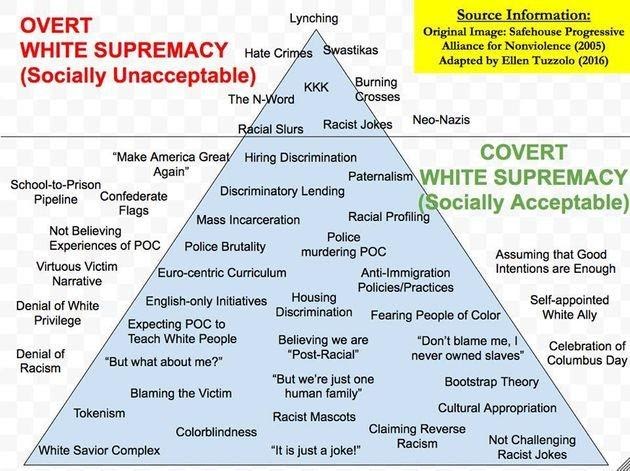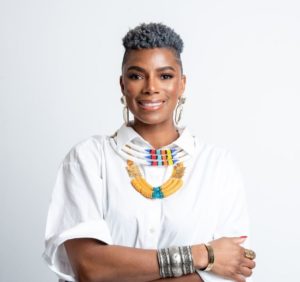5 equity-based strategies to get you started on making Black lives matter in the workplace.
A guide for white leaders and employees.

We’ve all seen the news and the inhumane treatment of Black people globally.
Here in Canada, we’ve seen many Black people and allies alike take to the streets, during a pandemic, no less, to protest the racist treatment of Black people.
CNN host, Don Lemon, puts the gravitas of the effect of racism into perspective by juxtaposing it with a global pandemic. In a recent broadcast, he states that there are two major crises that are killing Black people, COVID-19 and Racism.
As you enter the physical and virtual workplace this week, know that your Black employees, customers, and partners are seeing the world through a different set of lenses than you.
The conversation surrounding race can no longer be avoided. It’s time to lean into your courage and leverage your Emotional Intelligence for a more equitable workplace. Here are 5 equity-based strategies to help you get started on making Black lives matter in the workplace:
1. Bridge The Empathy Gap with Black Employees - Reach Out and Demonstrate You Care
Your voice matters, especially when you are a leader or an influential figure and especially if you are white. Leaders have to be bold enough to state the obvious and call out racism. The conversation can no longer be avoided because it is hard. We have to have it Now.
Masai Ujiri, President Toronto Raptors
Your voice matters, especially when you are a leader or an influential figure and especially if you are white. Leaders have to be bold enough to state the obvious and call out racism. The conversation can no longer be avoided because it is hard. We have to have it Now.
Masai Ujiri, President Toronto Raptors
Instead of asking how their weekend was, or the generic “how are you,” here are some useful conversation prompts you can use to open up a dialogue with racially diverse employees. Note that they’re already carrying #Racial and #EmotionalTax, so be proactive and don’t wait for employees to come to you. Reaching out, putting out a statement and taking action also let your customers know that you care, that Black lives and not just Black money matters. Not saying anything is saying loudly that Black lives don’t matter. If you are uncomfortable with this, then you are on the right track.
- I’ve seen the news, and I don’t know what it’s like to see Black lives of loved ones killed and threatened daily. Let me know how I can support you.
- I know that racism and anti-Black racism exist in Canada and I will do my part to do better, starting today.
- I’m here to listen.
- I’ve donated to x organization, if there are a few others you’d like to suggest, let me know.
- How can I be helpful to you?
- What would support look like for you?
- Is there someone else you would like to speak to other than me? (Having someone who looks like you eases that burden of emotional tax and gives an immediate sense of “being seen and heard.” Ensure that there are racially and culturally diverse wellness practitioners in your EAP – Employee Assistance Program offerings to increase relatability.)
- How can I make your day easier?
- I don’t want to assume that you are okay or that you are not – I want you to know that I am here for anything you need.
2. Address The Elephant In The "Race" Room
The Majority of Canadians who are Black (54%) or Indigenous (53%) have personally experienced discrimination due to race or ethnicity from time to time, if not regularly, in the workplace.
Race Relations in Canada 2019 Survey by Environics Canada
The Majority of Canadians who are Black (54%) or Indigenous (53%) have personally experienced discrimination due to race or ethnicity from time to time, if not regularly, in the workplace.
Race Relations in Canada 2019 Survey by Environics Canada
The Race Relations in Canada report was published before COVID and the racial trauma we are all witnessing today. Racism does exist in the workplace. There are overt and covert, (or explicit and implicit) forms of racism. As noted below – these covert socially acceptable behaviours are what we call the “Elephant in The Room.” Throughout the years at KDPM’s Institute for Inclusive Behaviour, our inclusion work has largely focused on helping leaders understand the harmful impact of overt and covert racist behaviours on the health and well-being of Black and other racialized groups.

Effectively addressing the elephant in the “race” room begins by increasing accountability at all levels, starting with the individual responsibility to learn about White SPF – white supremacy, privilege, and fragility unlearn the covert socially acceptable behaviours that are killing and harming Black people. White people must relearn less harmful behaviour that reflects one’s values, and it starts with acknowledging the “elephant in the room” – racism and anti-Black racism exists in Canada, this isn’t just the US problem. Inclusive leadership behaviour that reflects your organization’s mission and vision must include anti-Black racist behaviour (this begins with understanding your White SPF). If your leaders are unaware of what anti-Black racist behaviour means, how can you ensure that your leaders are inclusive? Find an example of what not to do under the Amy Cooper file. Dr. Sarah Saska, Co-Founder & CEO, Feminuity says:
“Many white leaders are quick to vilify the Amy Cooper’s of the world, while in the same breathe, reminding the world that they are *not like her.* That they are the ‘good’ white people who would never do such a thing. That they are *obviously* not racist. In my experience, the quickest way to determine if a white person has done the work is to show them another white person behaving badly to see how quickly they try to separate from them or position themself as different, as better. As white people, our worlds are viewed through a lens that honours, elevates, and privileges whiteness. This means we need to do the work. In the process, we will find dark, ugly, and unspeakable things that we must reconcile within ourselves. We need to say these things out loud to ourselves and to other white people and we need to think about how they came to be ‘true’ for us. Working to combat anti-Black racism is something we must work on every single day.”
3. Your Equity, Diversity, and Inclusion Strategy must be Human-Centered
Don’t allow your discomfort to reduce what’s happening in the world to an “equity for all” moment. Be okay with saying capital “B,” Black.
Shavonne Hasfal McIntosh, Head of Diversity and Belonging, Shopify
Don’t allow your discomfort to reduce what’s happening in the world to an “equity for all” moment. Be okay with saying capital “B,” Black.
Shavonne Hasfal McIntosh, Head of Diversity and Belonging, Shopify
Inclusion begins with ‘I.’ To address anti-Black racism in the workplace, leaders must embrace a new radical human-centred model of equitable leadership and integration.
Over the years, our work has revealed that most inclusion strategies place leaders at the helm of leading without examining their role in implementing and executing organization-wide strategies. Leaders who lead without reflecting and embodying these understandings work to reinforce a unique dissociation between leaders and employees. This dissociation supports and contributes to what Leesa Renee Hall refers to as the “intellectualization of racism.” Hall contends:
“Intellectualization of racism, the process of thinking about or discussing a subject in a particular way without involving your emotions or feelings, is a defence mechanism designed to prioritize your need to be seen, acknowledged, or congratulated. Intellectualization is the reason you see me as a resource, and not as a person. Intellectualization is the reason you spend hours commenting and replying to dozens of posts, and not taking action to uproot your unconscious biases. Intellectualization is the reason you seek stats, facts, and data, rather than believing the words that a person of African descent uses to describe their lived experience.“
Thus, inclusion strategies that are human-centred are better able to ensure a more equitable approach that puts human stories and experiences at the centre of relatedness.
Developing and implementing accountability frameworks is the single most significant action organizations can take right now to ensure equitable outcomes are realized.
Kike Ojo-Thompson, The Kojo Insitute
Developing and implementing accountability frameworks is the single most significant action organizations can take right now to ensure equitable outcomes are realized.
Kike Ojo-Thompson, The Kojo Insitute
Many organizations and diversity and inclusion leaders have intellectualized their inclusion strategy. At KDPM’s Institute For Inclusive Behaviour, we use inclusive journey maps highlighting the lived experience for all humans. Eradicating anti-Black racism isn’t the responsibility of Black people, rather it is the responsibility of those who are upholding and, in some cases, contributing to the systemic barriers and policies perpetuating the status quo.
Here’s what a human-centred design can look like with a focus on social issues that may challenge an organization’s inclusion and human optimization goals, known as what we call the “Elephant in The Room.”
- Placing race at the center of your workplace culture and leadership design allows for Black employees to share their leadership experiences from hiring to advancement to exiting the workplace.
- Exploring White SPF – white supremacy, white privilege, and white fragility allows White and non-Black employees an opportunity to uncover their blind spots, biases, both conscious and unconscious, and the role their experiences and action play in creating more barriers or upholding barriers that impact racialized people.
The intersections of our identities will also provide insight into where there are other complexities and barriers and provide more in-depth insight into their experiences as well.
4. ERGs as Equity Partners: Re-ImagineERGs and their Strategic Involvement
This is a time for leaders within the corporate space to practice compassion for their Black staff. It’s necessary for them to engage and have a meaningful discussion about their Black experience, to listen intently, and to be proactive in their allyship by educating themselves on how they can do a better job of creating a more equitable society.
Meryl Afrika, President, Canadian Association of Urban Financial Professionals
This is a time for leaders within the corporate space to practice compassion for their Black staff. It’s necessary for them to engage and have a meaningful discussion about their Black experience, to listen intently, and to be proactive in their allyship by educating themselves on how they can do a better job of creating a more equitable society.
Meryl Afrika, President, Canadian Association of Urban Financial Professionals
Employee Resource Groups (ERGs), specifically, Black Employee Resource Groups, are much more than social groups. ERGs must be treated as equity partners. Most corporate companies are not supporting, including, or leveraging Black ERGs as much as they could be. To start, are the members of your ERGs being compensated for their efforts? They should be, otherwise, their contributions are unpaid, which can further pay equity. Reflect on the role your Black ERG can play (or currently plays) to determine if they are positioned as an equity partner. What would be different? Would the leadership roundtable look different? Would there be more diverse voices, stories, and experiences at the table? Would there be a higher representation of Black leaders at the decision-making table? If the answer is no and has been no for a while now is the perfect time to begin.
Reflect on the role your Black ERG can play (or currently plays) to determine if they are positioned as an equity partner. What would be different? Would the leadership roundtable look different?
5. Prioritize the Well-Being of Black Employees
When people experience racism, stress is tripled for a person of colour. It shortens their life, especially when there is nothing a person can do.
Dr. Kwame McKenzie, CEO, The Wellesley Institute, source: Race, Mental Health and The Workplace
When people experience racism, stress is tripled for a person of colour. It shortens their life, especially when there is nothing a person can do.
Dr. Kwame McKenzie, CEO, The Wellesley Institute, source: Race, Mental Health and The Workplace
Racism and inequity are health issues. Every morning, Black people prepare to protect themselves from unfair treatment and negative attention inside and outside the workplace. They experience acts of bias, exclusion, and discrimination so often that they’ve grown to anticipate it daily. This adds up to an emotional tax, which research has shown impacts their overall health and well-being. Now examine the weight of this during COVID and this time in history.
Here is an insight into an employee’s experience:
“On Friday I had to sit through a weekly check-in video conference with my co-workers, who spoke about their weekend plans and other light-hearted topics, while I sat there smiling and trying to hide the fact that I was emotionally devastated. A wound deepened by the fact that not one person engaged with me offline to see how I was feeling about what is happening in society today, but instead only engaged with me to see where I was at with that next deliverable. I know that I am not alone in having experienced this deafening silence.”
If your Black employees called your Employee Assistance Line right now for the double emotional tax, will they have access to racially and culturally diverse wellness experts? Will they have access to a Black Therapist, Holistic Wellness Coach, etc.? Or, will they be subject to a white therapist or coach, who is likely to have far less understanding of their experience? In the words of American writer, professor, editor, and social commentator, Roxanne Gay in her New York Times piece:
“Eventually, doctors will develop a coronavirus vaccine, but Black people will continue to wait for a cure for racism.”
CEOs, diversity and inclusion leaders are part of the cure for racism. Don’t expect your Black employees to continue to bear the weight of exclusion. Hire Black, Indigenous, and People of Colour to help start the conversation on what can be done differently and pay them the same rate you pay white people. Support and donate to organizations doing the work in our communities and most importantly, commit to a year-long journey required for anti-Black racism, unpacking white SFP and equity work. As reminded by Dr. ABC, Equity work is courageous work:
“Why are we not seeing the change we so desire? It is because persons with power and authority to make changes are not making those changes. Many of our leaders have settled for the checked-box approach. Equity work is courageous work. Equity work is transformational and transformative work. Equity work is ethical and moral work. It is not paper-work. It is not something we get to check off on the meeting’s agenda. I say to leaders – you are not hopeless and helpless, use your power and privilege to dismantle systematic oppression and create access, opportunity and space for equity-seeking groups. You have to be more than upset and concerned; you have to be intentional and deliberate about equity and inclusion.” – DR.ABC, May 30, 2020, Ph.D., M.Ed., B.A., Dip. Ed., OCT, University of Toronto, Faculty (Adjunct) – Graduate Studies
Do the human thing. Your employees, customers, and colleagues are Black – how will your show that their Black lives matter?
Action You Can Take Now
Support the Black experts quoted in this article by donating to their organizations and organizations we support through KDPM Institute For Inclusive Behaviour:

Karlyn Percil
Karlyn Percil is the CEO of KDPM Consulting Group, and the founder of SisterTalk Group — a diverse women’s network, where she facilitates a 7 week self-discovery program for women. You can learn more about Karlyn and find more of her writing on her Perspectives page. To book an anti-Black racism, equity, diversity, and inclusion conversation or consultancy session or to explore any of the points above further, contact us bookings@elmgmtgroup.com.
